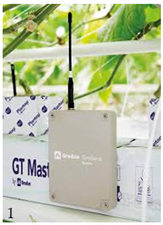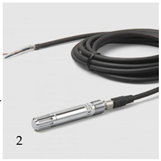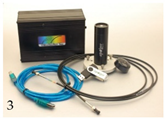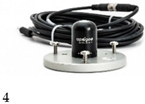Protected cropping produces more food per land area than field-grown crops. Protected cropping includes low-tech polytunnels utilizing protective coverings, medium-tech facilities with some environmental control, and high-tech facilities such as fully automated glasshouses and indoor vertical farms. High crop productivity and quality are maintained by using environmental control systems and advanced precision phenotyping sensor technologies that were first developed for broadacre agricultural and can now be utilized for protected-cropping applications. The adoption of climate monitoring and control technologies and precision phenotyping methodologies in protected cropping is required for sustaining future food security and enhancing nutritional quality.
- precision phenotyping
- protected cropping
- sensor technology
1. Introduction
2. Using Phenotyping to Advance the Protected-Cropping Industry
A crop phenotype is the observable characteristics that are expressed as a result of a genotype’s interaction with the environment. Phenotyping is the science of the characterization of the crop’s traits such as growth, development, architecture, physiology, health, nutrition, and yield. While many plant phenotyping techniques have been developed for the purpose of breeding, disease detection, and improving stress tolerance for field crops [12][13][14], phenotyping is also used to monitor plant health, development, disease manifestation, and fruit quality so that growers can take early action to change abiotic conditions and maximize the yield of crops. Crop phenotyping can optimize breeding programs for new varieties that will produce food of high nutritional and aesthetic quality [15]. With appropriate phenotype monitoring, resource-use efficiency can be maximized [16][17]. Crop phenotyping is an essential process in vegetable and fruit production and is particularly important to mitigate the impacts of climate change, as new varieties of heat- and drought-tolerant fruit and vegetables will have to be developed in the future to maintain crop yield and quality. Currently, assessment of phenotype characteristics relies largely on visual scoring methods by experts, which is time-consuming and can introduce bias via human error [15]. Thus, plant phenotyping has become a field for innovation to hasten breeding programs and quality assessment, pre- and post-harvest. High-throughput phenotyping (HTP) platforms have been developed and are being used to collect data for quantitative studies of complex traits related to the growth, yield, and adaptation to biotic (e.g., disease and insects) and abiotic (e.g., drought and salinity) stress. There are a number of techniques available or in development to assess these traits; however, to properly assess phenotypic expression, it is also important to measure and control the environmental parameters to which a crop is exposed, as phenotypic expression is highly dependent on environmental conditions. While much of the tools used for precision phenotyping were developed for broadacre crops, these technologies are being transitioned to protected-cropping facilities in various ways [10]. Once systems are developed to streamline precision phenotyping in protected cropping, these data-collection systems can be further integrated into automated control systems that will be able to autonomously make crop-management decisions based on the observed plant expression [4][18].3. Environmental Monitoring Is a Prerequisite for Plant Phenotyping
3.1. Phenotypic Plasticity in Response to Environmental Parameters
In addition to crop-related traits, effective phenotyping requires continuous assessment of environmental parameters. The environmental conditions in which a crop is grown must be known and, ideally, controlled for consistency across a crop cycle. The primary environmental conditions that impact crop growth are root-zone temperature, moisture and electrical conductivity (EC), light quality and quantity, air temperature, and relative humidity (RH). While some impacts of these environmental parameters on external and internal phenotypic expression are known [5], the field is being explored further as better methods of environmental and phenotypic monitoring become accessible.3.2. Root-Zone Temperature, Moisture Content, and Electrical Conductivity
Root-zone temperature, moisture and EC play key roles in crop performance. While controlling root-zone temperature is a by-product of maintaining optimal air temperature, substrate moisture and EC are controlled by irrigation and fertilization regimes. Irrigation timing impacts root development in soils and soilless substrates. A moisture-saturated root zone results in poor root development, and if this development is hindered early in the growth of the plant, that plant’s ability to produce and bear fruit is reduced because the root structure is not there to maintain it. In the case of hydroponic cultivation, EC is an indirect measure of nutrient availability and is crucial for nutrient uptake, and optimal EC is highly specific to the crop. EC that is higher than necessary results in stagnation of nutrient ions. High EC has been related to blossom end rot in tomatoes, as, with increasing EC, mass flow is reduced due to less water entering the plant roots [19]. Very low EC, in the case of hydroponic crops, can lead to root cell rupture due to the large imbalance of osmotic pressure across the root membrane. An example of sensor technology that measures root-zone EC, moisture, and temperature can be found in Table 1. Some root-zone temperature, moisture, and EC sensors can be integrated into sophisticated greenhouse and glasshouse control systems to dictate irrigation cycles to optimize plant access to water and nutrients throughout the crop’s growth cycle [20].| Environmental Parameter | Impact on Crop | Sensor | Control Mechanism | Example |
|---|---|---|---|---|
| Electrical conductivity (EC) | High: Blossom-end rot, nutrient deficiency, and reduced yield. Low: Cell rupture. |
Slab or soil EC sensors (usually include temperature and moisture measurements) | Irrigation regimes, pH modification, and EC modification of stock solution |  |
| Root-zone moisture | High: Roots do not develop enough to support a full-grown producing plant. Low: Root die-off and plant dehydration. |
Soil-moisture probes or slab or soil EC sensors (usually include temperature and moisture measurements) | Properly timed irrigation and proper landscaping to prevent pooling (slope) | |
| Root-zone temperature | High: >25 °C, NH4 toxification, leading to cell death. Low: 3–11 °C, NH4 uptake stimulates plant growth. |
Soil-temperature and moisture probes that include EC measurements | Shade cloth, irrigation solution temperature, heating pad, and heating cables | |
| Air temperature | High: Leaf dehydration and earlier stomatal shutdown. Metabolic shutdown due to inability to dissipate heat. Low: Delayed blooming and stunted or slow growth. Large day–night temperature differentials impact fruit set. |
Dual air-temperature and relative-humidity probes | Pad and fan cooling, cold-coil fan cooling, shade cloth to reduce radiant heat, hot-water pipes, and hot air via external heat source |  |
| Relative humidity | High: Low stomatal conductance, reducing nutrient distribution to plant and fruit. Low: Early stomatal shutdown, resulting in reduced photosynthesis. |
Dual air-temperature and relative-humidity probes | Misting system, condensing system, and dehumidification | |
| Light quality | 280 nm: Reduces quantum yield and rate of photosynthesis. 315–400 nm: Promotes pigmentation and thickens plant leaves. 400–440 nm: Promotes vegetative growth. 640–660 nm: Vital for flowering. 740 nm: Increases photosynthesis [21]. |
Spectroradiometer or a combination of PAR and net radiometer | Colored shade cloth, fluorescent films, and light supplementation |  |
| Light quantity | High: Leaf dehydration, sunscald, photodamage, and lowered photosynthetic rates. Low: Stem elongation, lower photosynthetic rate, reduced yield, misshapen fruit, and reduced shelf life. |
PAR sensors | Shade cloth and light supplementation with light-emitting diodes |  |
3.3. Light Quality and Quantity
Light quality and quantity impact plant development, as light is the main driver in crop production. It is estimated that light quantity is reduced by 30% in glasshouses due to structural shading; this paired with low light intensity of the winter months has been linked to low yields and the production of small fruit [22]. The protected-cropping sector has developed cladding material specifically created to not block solar radiation, as the whole spectrum of solar radiation plays an important role in plant development. Too little natural light leads to elongation of stems and low fruit yield. In cucumbers, fruit grown in low light conditions tends to be lighter in color and yellow more quickly once harvested [23]. Misshapen, swollen, and hollow tomato formations have also been documented as a result of low light conditions [22]. In contrast, a higher irradiance from the sun results in leaf dehydration and premature shutdown, leading to a reduced photosynthetic capacity and lower crop yield. Excess light can lead to sunscald in a wide range of crops, including tomatoes and capsicum [22]. In lettuce, high light environments can lead to the increased presence of tip burn [24]. Light quality also influences internal and external phenotypic expression. Plants primarily use photosynthetically active radiation (PAR), which consists of wavelengths from 300 nm to 700 nm. Red light exposure has been shown to reduce the bitter flavor in lettuce leaves [25], while UV-B exposure causes the accumulation of secondary metabolites, which influence a variety of plant physiological processes and internal quality of some vegetables [22]. In protected cropping, PAR sensors or global radiation sensors are used both outside and inside the growth compartments to monitor light levels (Table 1). These measurements can be and often are integrated into shade curtain control systems to ensure that crops are receiving appropriate light conditions throughout the day [26]. Light quality also plays a key role in taste and aroma profiles for different fruiting or vegetative plants. Light quality, intensity, and duration can be manipulated to elicit desired attributes of leafy greens, including leaf shape, leaf color, nutrition, flavor, texture, and aroma [27].3.4. Temperature and Relative Humidity (RH)
Temperature and RH are important environmental variables that must be maintained for proper crop development and to achieve maximum yield. With an increase in temperature, RH decreases, as RH is a measure of the percentage of moisture the air can hold as vapor at that particular temperature. As temperature increases, the air’s ability to hold more moisture increases. Crops also have different microclimate needs at different stages of development; thus, continuous measurement is necessary to maintain these parameters, which can be performed with a variety of sensors, an example of which can be found in Table 1. While these temperature and RH sensors are used to continuously monitor the microclimate, they are also the main trigger for misting/dehumidifying and heating/cooling systems to maintain optimal RH and temperatures, and they are essential tools for maintaining high crop yield and quality [28]. While optimal temperatures for day and night will vary with crop type and variety, the majority of horticultural crops are warm-weather plant species, with their main growing seasons occurring over the summer months. Typically, temperatures between 20 and 30 °C and with an RH of 50 to 80% are desirable; however, each crop variety has specific requirements. Cucumbers, for instance, have been shown to taste sweeter when grown in moderate RH as opposed to high RH and, in general, produce better fruit with respect to quality attributes and external appeal [29]. While air temperature is an important parameter, studies have shown that canopy (leaf) temperature may be far more important. Leaf temperature is directly related to transpiration rates and measurement of this parameter provides information about leaf temperature, as well as plant water status [30].3.5. Sensor Technology to Monitor Environmental Parameters
Consistent environmental conditions are essential for reproducible phenotypic responses from different genotypes. Therefore, if environmental conditions are tightly controlled, ideal plant growth and development can be achieved; thus, developmental stages can be identified and targeted to identify specific traits. Moreover, in tightly controlled conditions, deviations from typical phenotypic expression become more obvious and make assessing disease, plant health, and fruit quality more straightforward. There are various sensors available to monitor air temperature, RH, root-zone temperature, moisture, and EC, as well as light quantity and quality (Table 1). While all of these parameters, such as shade curtains or irrigation, can be monitored individually via computer or smartphone and the control mechanism changed manually, there are integrated hardware and software systems available that can automatically manage these environmental controls. Due to the variability of microclimates within protected-cropping facilities, high-resolution measurements are useful for correctly informing the grower on the overall environment that the crop is experiencing; thus, they can make more appropriate management decisions [31][32].3.6. Environmental Monitoring Is a Prerequisite for Plant Phenotyping
In summary, plants have plasticity to alter their phenotype, exhibiting different external and internal expression depending on the environment. Environmental control and data capture are important throughout the phenotyping process, as antecedent events can be inherited by the progeny, which is known as the ‘memory effect’ [33]. Frequent high-throughput phenotyping will promote faster phenotypic data acquisition for correlation with genomic information [34]. In protected cropping, phenotypic expression dictates fruit aesthetic and nutritional quality pre- and post-harvest, suggesting that two important subjects need to be considered:-
Precise control over crop microclimate to maintain desired phenotypic expression across crop cycles;
-
Frequent phenotypic surveys of plants and fruit, throughout the cropping cycle and during post-harvest sorting, storage, and distribution.
References
- United Nations, Department of Economic and Social Affairs, Population Division. World Population Prospects Highlights, 2019 Revision Highlights, 2019 Revision; United Nations: New York, NY, USA, 2019; ISBN 978-92-1-148316-1.
- FAO; CIRAD. Fruit and Vegetables – Opportunities and challenges for small-scale sustainable farming; FAO: Rome, Italy; CIRAD: Montpelhièr, France, 2021.
- OECD; Food and Agriculture Organization of the United Nations. OECD-FAO Agricultural Outlook 2021–2030; OECD-FAO Agricultural Outlook; OECD: Montpelhièr, France, 2021; ISBN 978-92-64-43607-7.
- Shamshiri, R.; Kalantari, F.; Ting, K.C.; Thorp, K.R.; Hameed, I.A.; Weltzien, C.; Ahmad, D.; Shad, Z.M. Advances in Greenhouse Automation and Controlled Environment Agriculture: A Transition to Plant Factories and Urban Agriculture. Int. J. Agric. Biol. Eng. 2018, 11, 1–22.
- Rabbi, B.; Chen, Z.-H.; Sethuvenkatraman, S. Protected Cropping in Warm Climates: A Review of Humidity Control and Cooling Methods. Energies 2019, 12, 2737.
- Shi, X.; An, X.; Zhao, Q.; Liu, H.; Xia, L.; Sun, X.; Guo, Y. State-of-the-Art Internet of Things in Protected Agriculture. Sensors 2019, 19, 1833.
- Davis, J. Growing Protected Cropping in Australia to 2030; Protected Cropping Australia: Perth, Australia, 2020; p. 15.
- Achour, Y.; Ouammi, A.; Zejli, D. Technological Progresses in Modern Sustainable Greenhouses Cultivation as the Path towards Precision Agriculture. Renew. Sustain. Energy Rev. 2021, 147, 111251.
- Talebpour, B.; Türker, U.; Yegül, U. The Role of Precision Agriculture in the Promotion of Food Security. Int. J. Agric. Food Res. 2015, 4, 1–23.
- Tripodi, P.; Massa, D.; Venezia, A.; Cardi, T. Sensing Technologies for Precision Phenotyping in Vegetable Crops: Current Status and Future Challenges. Agronomy 2018, 8, 57.
- Barnes, A.P.; Soto, I.; Eory, V.; Beck, B.; Balafoutis, A.; Sánchez, B.; Vangeyte, J.; Fountas, S.; van der Wal, T.; Gómez-Barbero, M. Exploring the Adoption of Precision Agricultural Technologies: A Cross Regional Study of EU Farmers. Land Use Policy 2019, 80, 163–174.
- Humplík, J.F.; Lazár, D.; Husičková, A.; Spíchal, L. Automated Phenotyping of Plant Shoots Using Imaging Methods for Analysis of Plant Stress Responses—A Review. Plant Methods 2015, 11, 29.
- Mahlein, A.-K. Plant Disease Detection by Imaging Sensors—Parallels and Specific Demands for Precision Agriculture and Plant Phenotyping. Plant Dis. 2015, 100, 241–251.
- Yang, W.; Duan, L.; Chen, G.; Xiong, L.; Liu, Q. Plant Phenomics and High-Throughput Phenotyping: Accelerating Rice Functional Genomics Using Multidisciplinary Technologies. Curr. Opin. Plant Biol. 2013, 16, 180–187.
- Li, L.; Zhang, Q.; Huang, D. A Review of Imaging Techniques for Plant Phenotyping. Sensors 2014, 14, 20078–20111.
- Fiorani, F.; Schurr, U. Future Scenarios for Plant Phenotyping. Annu. Rev. Plant Biol. 2013, 64, 267–291.
- Riley, R.C.; Cavagnaro, T.R.; Brien, C.; Smith, F.A.; Smith, S.E.; Berger, B.; Garnett, T.; Stonor, R.; Schilling, R.K.; Chen, Z.-H.; et al. Resource Allocation to Growth or Luxury Consumption Drives Mycorrhizal Responses. Ecol. Lett. 2019, 22, 1757–1766.
- Ting, K.C.; Lin, T.; Davidson, P.C. Integrated Urban Controlled Environment Agriculture Systems. In LED Lighting for Urban Agriculture; Kozai, T., Fujiwara, K., Runkle, E.S., Eds.; Springer: Singapore, 2016; pp. 19–36. ISBN 978-981-10-1848-0.
- Adams, P.; Ho, L.C. The Susceptibility of Modern Tomato Cultivars to Blossom- End Rot in Relation to Salinity. J. Hortic. Sci. 1992, 67, 827–839.
- Cobden, J.; Grodan GroSens®. WC, TEMP and EC Meter. In AIS Greenworks; Available online: https://www.aisgreenworks.com.au/grodan-grosens-wcm/ (accessed on 13 September 2022).
- Van der Zwart, E. Understanding LED Wavelength for Horticulture. In Proceedings of the LED Event 2018, Den Bosch, The Netherlands, 21–28 November 2018.
- Gruda, N. Impact of Environmental Factors on Product Quality of Greenhouse Vegetables for Fresh Consumption. Crit. Rev. Plant Sci. 2005, 24, 227–247.
- Bakker, J.C.; Bot, G.P.A.; Challa, H.; van de Braak, N.J. Greenhouse Climate Control: An Integrated Approach; Wageningen Academic Publishers: Wageningen, The Netherlands, 1995; ISBN 978-90-74134-17-0.
- Gaudreau, L.; Charbonneau, J.; Vézina, L.-P.; Gosselin, A. Photoperiod and Photosynthetic Photon Flux Influence Growth and Quality of Greenhouse-Grown Lettuce. HortScience 1994, 29, 1285–1289.
- Eskins, K.; Warner, K.; Felker, F.C. Light Quality During Early Seedling Development Influences the Morphology and Bitter Taste Intensity of Mature Lettuce. (Lactuca Sativa) Leaves. J. Plant Physiol. 1996, 147, 709–713.
- What Is Sunlight? Available online: https://support.priva.com/hc/en-us/articles/360019407880-What-is-sunlight (accessed on 9 September 2022).
- Runkle, E.; Meng, Q. Far Red is the New Red; Inside Grower: West Chicago, WV, USA, 2017; Volume 2, pp. 26–30.
- Bhujel, A.; Basak, J.K.; Khan, F.; Arulmozhi, E.; Jaihuni, M.; Sihalath, T.; Lee, D.; Park, J.; Kim, H.T. Sensor Systems for Greenhouse Microclimate Monitoring and Control: A Review. J. Biosyst. Eng. 2020, 341–361.
- Ali, H. Impact of Preharvest Relative Air Humidity and Postharvest Modified Atmosphere Packaging on Cucumber Fruit Quality. Master’s Thesis, Norwegian University of Life Sciences, Ås, Norway, 2017.
- Shamshiri, R.R.; Jones, J.W.; Thorp, K.R.; Ahmad, D.; Man, H.C.; Taheri, S. Review of Optimum Temperature, Humidity, and Vapour Pressure Deficit for Microclimate Evaluation and Control in Greenhouse Cultivation of Tomato: A Review. Int. Agrophysics 2018, 32, 287–302.
- Teitel, M.; Atias, M.; Barak, M. Gradients of Temperature, Humidity and CO2 along a Fan-Ventilated Greenhouse. Biosyst. Eng. 2010, 106, 166–174.
- López, A.; Valera, D.L.; Molina-Aiz, F.D.; Peña, A. Sonic Anemometry to Evaluate Airflow Characteristics and Temperature Distribution in Empty Mediterranean Greenhouses Equipped with Pad–Fan and Fog Systems. Biosyst. Eng. 2012, 113, 334–350.
- Pieruschka, R.; Schurr, U. Plant Phenotyping: Past, Present, and Future. Available online: https://spj.sciencemag.org/plantphenomics/2019/7507131/ (accessed on 27 April 2020).
- Solanke, A.U.; Kumar, P.A. Phenotyping of Tomatoes. In Phenotyping for Plant Breeding: Applications of Phenotyping Methods for Crop Improvement; Panguluri, S.K., Kumar, A.A., Eds.; Springer: New York, NY, USA, 2013; pp. 169–204. ISBN 978-1-4614-8320-5.
